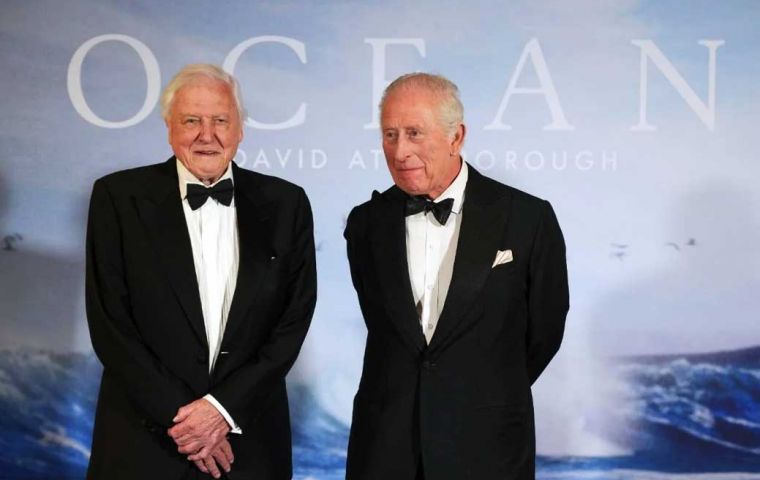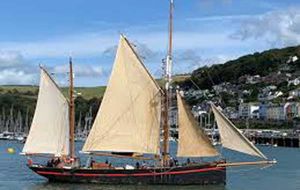MercoPress. South Atlantic News Agency
Great triumph for David Attenborough and his Ocean film: end of bottom trawling??
 Sir David Attenborough and King Charles at the United Nations Ocean Conference (UNOC-3) in the French city of Nice
Sir David Attenborough and King Charles at the United Nations Ocean Conference (UNOC-3) in the French city of Nice  The first fishing boats that pulled big nets, the so-called ‘Brixham trawlers’ of the early 1800s, were sail-driven, but by the 1870s there were steam trawlers
The first fishing boats that pulled big nets, the so-called ‘Brixham trawlers’ of the early 1800s, were sail-driven, but by the 1870s there were steam trawlers At the age of 99, the documentary film-maker David Attenborough has achieved his greatest triumph. With a single film clip, he has signed the death warrant for one of the world’s most destructive industries: bottom trawling. The companies and countries that do it will go down fighting and it will take time, but they will go down.
His film Ocean, got a simultaneous global release last month to build pressure for a ban on bottom trawling before the third United Nations Ocean Conference (UNOC-3) this week in the French city of Nice. The ban won’t happen this week and it won’t happen everywhere at once, but it is inevitable once enough people have seen that clip. You can’t forget it.
It’s long shots from underwater cameras at the mouth of an enormous net (you can’t see the sides or the top). The bottom of the net, weighed down so it scrapes along the seabed, swallows up everything in its path – fish, crustaceans, plants, mud – as it advances inexorably, faster than a walking pace, throwing up a plume of muck in its wake.
These bottom trawlers have been working at sea for more than a century, but nobody had ever seen this scene before. No diver would survive where the cameras were, presumably fixed to the net’s mouth by some rig that let them see the whole process.
It is a nightmare vision of mass death and destruction. No doubt the owners of the commercial trawler that Attenborough’s producers hired for this sequence were well paid, but they unwittingly sold out their whole industry.
Bottom trawlers are responsible for the bulk of the damage that human beings have done to the oceans. More than half the fish they catch are ‘bycatch’, thrown back into the water dead or dying because the trawlermen are only after a couple of species that bring a good price. And the ‘clean shave’ they give the bottom leaves nowhere for juvenile fish to hide.
The first fishing boats that pulled big nets behind them, the so-called ‘Brixham trawlers’ of the early 1800s, were sail-driven, but by the 1870s there were steam trawlers in Britain that could drag much bigger nets and catch ten times as much fish. The global fishing catch then may have been as little as 5 million tonnes annually, but it went up fast.
With the advent of ‘factory freezers’ in the mid-20th century – big ships that could travel to distant waters, catch up to 400 tonnes of fish every time they released their nets, and mechanically gut, fillet and fast-freeze the ones they wanted, dumping the rest – total catch reached 30 million tonnes a year by 1950.
It peaked at 130 million tonnes in 1996, by which time almost every major fishery in the world was being depleted. Human beings have even changed the structure of ocean fish populations. Big, predatory ‘table fish’ (the kind people like to eat) have declined by two-thirds, while the biomass of smaller prey fish, facing fewer predators, has gone up.
The worst of it is that while the official UN goal is to have 30% of the world’s oceans in ‘maritime protected areas’ by 2030, most of those MPAs still allow bottom trawling. We cannot rebuild healthy oceans unless that is stopped in the safe zones where fish populations should be able to recover, which is why Attenborough has made that his primary goal.
It won’t happen at UNOC-3, but it is being heavily debated there. The European Union will be moving on the issue soon, and where they go others will follow. But if they really do stop bottom-trawling those zones, what will people eat?
“We are eating bait and moving on to jellyfish and plankton,” warns Daniel Pauly of the University of British Columbia, but we may be spared that fate by the dramatic rise in the consumption of farmed fish. Half the protein people eat from all marine and freshwater sources is already from fish-farms, and the ratio is rising.
Moreover, the FIFO number (‘fish in/fish out’) is steadily improving. It really used to be the ‘little fish in/big fish out’ ratio, with three tonnes of little fish ground up for fish meal and fish oil to produce one tonne of salmon or trout, but now fish feed is mostly plant-based and even big cage-raised predators are net neutral, one in/one out.So the oceans, while still in terrible shape, are getting better, at least as far as fish are concerned. Now all we have to do is reverse the acidification process, stop sea level rise, and keep the Atlantic Meridional Overturning Current (the ‘Gulf Stream’) from collapsing. Can you start next week?




Top Comments
Disclaimer & comment rulesCommenting for this story is now closed.
If you have a Facebook account, become a fan and comment on our Facebook Page!